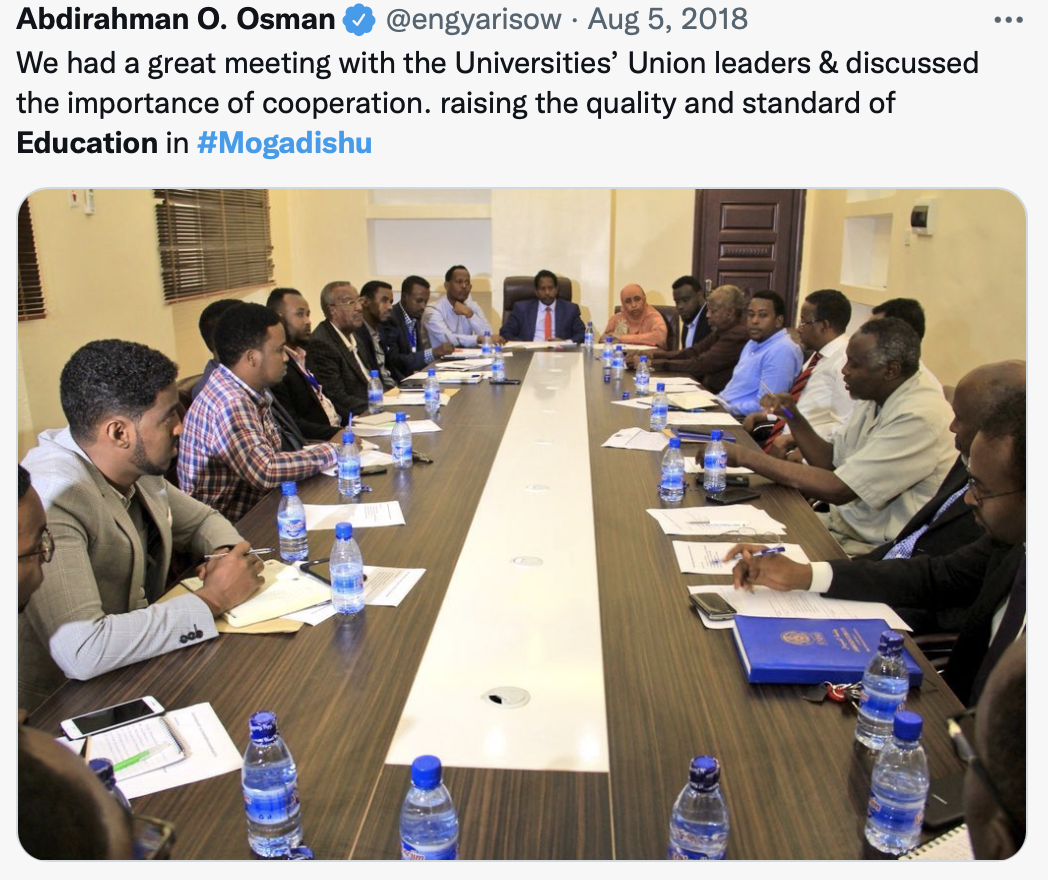Disclaimer:
Please be aware that the content herein has not been peer reviewed. It consists of personal reflections, insights, and learnings of the contributor(s). It may not be exhaustive, nor does it aim to be authoritative knowledge.
Title
Please provide a name for your action learning plan.
Improving the quality of education in Somalia's innovation ecosystem.
Challenge statement
Challenge type: If you are working on multiple challenges, please indicate if this is your "big bet" or "exploratory" challenge.
Please note: we ask you to only submit a maximum of 3 challenges - 1x Big Bet, 2x Exploratory. Each challenge must be submitted individually.
BIG BET
Challenge statement: What is your challenge? (Please answer in specific terms: "Our challenge is that...”.)
The current formal/informal systems of education are not supporting young people to think out of the box and develop life skills or take advantage of new opportunities in governance, digital Economy, innovation, research, and continued education. Our challenge is to find points of intervention, modification or change of direction to best improve quality of education in a challenging environment in Somalia.
Background: What is the history of your challenge? What is causing or driving it? Who is involved? How does the current situation look like? What undesired effects does it produce?
Somalia is going through economic and societal change with a growing population and a continued state of vulnerability to humanitarian crisis (Education Sector Analysis, 2022). The population is relatively young in a country of 16 million in 2020 of which half is eligible to attend school. Progress was made in institutionalization of education system despite continued low enrolment rates. The educational structure was improved through the adoption of the General education acts in February 2021. While many private schools, colleges, universities, and training centers complement government efforts in education. However, the question of quality of education and skill building offered by both public and private institutions remains a difficult one to answer. With a lack of assessment data, new examination systems and high pass rates indicated a disparity in quality of education and skill building offered by institutions. This lack of quality education was also identified as one of the key factors hindering the effectiveness of capacity building efforts done by UNDP.
Quantitative evidence: What (official) data sources do you have on this challenge that better exemplifies the importance and urgency of this frontier challenge? You can add text, a link, or a picture.
Surveys and reports on : National youth strategy, educational sector analysis 2022, Demographic governmental data.
Qualitative evidence: What weak signals have you recently spotted that characterizes its urgency? Please provide qualitative information that better exemplifies the importance and urgency of this frontier challenge. You can add text, a link, or a picture.
In discussions with Youth groups in the north and south of the country a majority of participants highlighted the importance of improving quality of capacity building, education and upskilling.
Value proposition: What added value or unique value proposition is your Accelerator Lab bringing to solving this challenge? Why is it your Lab that needs to work on this challenge and not other actors within UNDP, other stakeholders in the country respectively? Why is it worth investing resources to this challenge?
Our lab will speak with different stakeholders (private, innovation hubs, youth centers, universities, and government) so we can find ways to bridge the gap between capacity building/education and opportunities, challenges and needs of Somalia. From our previous work with youth, and involvement in different aspects of the innovation ecosystems we found a high level of duplication and disorganization in terms of education, trainings, and capacity building by various actors while there is no active monitoring by government agencies. The reality is education(formal/informal) is disconnected from employment opportunities. Our lab would bring access to new methodologies as a network e.g. South to south cooperation and leveraging the partnerships already existing within the network. These partnerships would help us explore new innovative methodologies to improve educational and training efforts. In addition to finding solutions to the problem from other areas. Then connecting these to and existing platform solution we helped develop as part of the Digital X program.
Short “tweet” summary: We would like to tweet what you are working on, can you summarize your challenge in a maximum of 280 characters?
Join us to improve and innovate education in Somalia #UNDPSomalia #SDG4 #QualityEducation #UNDPAccLabs
Partners
Who are your top 5 partners for this challenge? Please submit from MOST to LEAST important and state Name, Sector and a brief description of the (intended) collaboration.
Please state the name of the Parter:
UNICEF
What sector does our partner belong to?
United Nations
Please provide a brief description of the collaboration.
We might work with UNICEF in trainings and programs for STEAM training.
Is this a new and unusual partner for UNDP?
Yes
Who are your top 5 partners for this challenge? Please submit from MOST to LEAST important and state Name, Sector and a brief description of the (intended) collaboration.
Please state the name of the Parter:
UNFPA
What sector does our partner belong to?
United Nations
Please provide a brief description of the collaboration.
In this collaboration Acclabs and UNFPA are partnering on a project to improve and redesign a number of youth centres in different cities within Somalia.
Is this a new and unusual partner for UNDP?
No
Who are your top 5 partners for this challenge? Please submit from MOST to LEAST important and state Name, Sector and a brief description of the (intended) collaboration.
Please state the name of the Parter:
Innovation hubs (Shaqdoon, Harhub, T-hub)
Learning questions
Learning question: What is your learning question for this challenge? What do you need to know or understand to work on your challenge statement?
What are the gaps? How we can bring the skills and opportunities gap ? How do these gaps differ by location or group (IDP, PWD, girls etc.)? How can we improve quality of educations or trainings? How can we address the engagement question in capacity building exercises and methods?
To what stage(s) in the learning cycle does your learning question relate?
Sense, Explore
Usage of methods: Relating to your choice above, how will you use your methods & tools for this learning question? What value do these add in answering your learning question?
Collective intelligence will used with stakeholders to tackle the scope of the problem and understand the current educational context across different locations. Then conduct detailed interviews with key decision makers in education. In addition to field visits to some of the innovation hubs across three regions while establishing relations with other similar innovation hubs in Spain with the assistance of the government of Catalonia. Also conducting foresight workshops with UNFPA and Ministry of Youth to identify future directions for education. All this input from all of these methodologies can be used as a basis for mapping best interventions and leveraging points using systems thinking then design a proof of concept pilot for the benefit of the ministry of education or other stakeholders in the ecosystem.
Existing data gaps: Relating to your choice above, what existing gaps in data or information do these new sources of data addressing? What value do these add in answering your learning question?
The lack of statistics data from the ministry of education regionally and across the whole country.
Closing
Early leads to grow: Think about the possible grow phase for this challenge - who might benefit from your work on this challenge or who might be the champions in your country that you should inform or collaborate with early on to help you grow this challenge?
1. Joint-programs proposal with UNFPA for development of existing youth centers and expansion to new locations. 2. Future capacity building exercises which UNDP will be doing across portfolio’s and projects. 3. Youth programming could benefit from the priorities/gaps and recommendations for transition from learning to earning which could benefit the program itself. 4. Policy recommendations for the government side to improve (quality of edu) along with our other partners.
END OF ACTION LEARNING PLAN: Thank you! The form saves automatically and your submission has been recorded. You may now exit this window.


 4
4
 8Decent work and economic growth
8Decent work and economic growth 9Industry, innovation and infrastructure
9Industry, innovation and infrastructure 11Sustainable cities and communities
11Sustainable cities and communities
Comments
Log in to add a comment or reply.